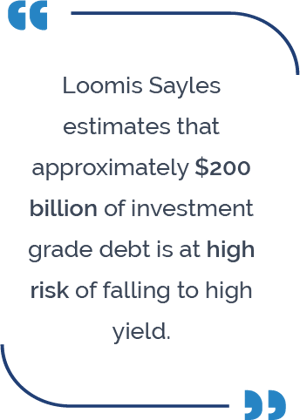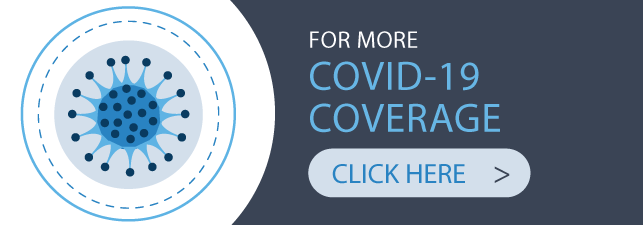In March, you were not overly concerned about the potential for a massive downgrade in BBB debt. How do you view that possibility now?
 The economic downturn turned out to be more severe than anticipated in March and led to a sharp deterioration in credit metrics, which were already stretched in some areas heading into 2020. Credit ratings downgrades outpaced upgrades by a wide margin in the first half of 2020. Fallen angels (downgrades from investment grade to high yield) were $153 billion during the period, approximately one third of total investment grade downgrade volumes.[i] Most of the downgrades occurred in March, and we have seen a slowdown in downgrade activity since that time. Looking ahead, we see the potential for significantly more fallen angels. Loomis Sayles estimates that approximately $200 billion of investment grade debt is at high risk of falling to high yield.[ii] We believe the actual amount downgraded will largely depend on how soon the US economy is able to sustain a meaningful recovery. On the positive side, we believe Federal Reserve policies, which include purchases of investment grade corporate bonds and exchange-traded funds (ETFs), including certain fallen angels, may potentially minimize any market dislocations from downgrade activity.
The economic downturn turned out to be more severe than anticipated in March and led to a sharp deterioration in credit metrics, which were already stretched in some areas heading into 2020. Credit ratings downgrades outpaced upgrades by a wide margin in the first half of 2020. Fallen angels (downgrades from investment grade to high yield) were $153 billion during the period, approximately one third of total investment grade downgrade volumes.[i] Most of the downgrades occurred in March, and we have seen a slowdown in downgrade activity since that time. Looking ahead, we see the potential for significantly more fallen angels. Loomis Sayles estimates that approximately $200 billion of investment grade debt is at high risk of falling to high yield.[ii] We believe the actual amount downgraded will largely depend on how soon the US economy is able to sustain a meaningful recovery. On the positive side, we believe Federal Reserve policies, which include purchases of investment grade corporate bonds and exchange-traded funds (ETFs), including certain fallen angels, may potentially minimize any market dislocations from downgrade activity.
Did you take advantage of any opportunities to dial up portfolio risk in the second quarter?
We had positioned the product very defensively going into early 2020. Our allocations to government and government-related debt were at a decade high. This positioning reflected our belief at the time that we were in the late expansion phase of the credit cycle, with risk assets generally priced at very full valuations and offering relatively little incremental upside per unit of risk.
This up-in-quality positioning allowed Core Plus portfolios to largely participate with the strong index returns during the worst of the crisis and provided our investors with an important hedge against the broad risk-off environment in equities, credit and securitized credit markets. Significantly, we monetized a portion of our US Treasury, Treasury inflation-protected securities (TIPS), agency MBS and agency CMBS exposure during the Fed buyback programs, which provided timely liquidity to re-allocate back into risk markets at what we believed were very attractive valuations.
Starting in mid-March and through the second quarter, we began a tactical rotation back into risk markets as spreads widened out and became more attractive. We added to our investment grade (IG) and high yield (HY) credit exposure as we believe the US corporate sector has entered the credit repair phase of the credit cycle. In credit repair, companies typically emphasize rebuilding balance sheet quality and liquidity, which can drive corporate spreads tighter. Other risk asset purchases included additional bank loan exposure, ABS and CMBS, as well as some US dollar-denominated emerging market debt and local-pay Mexican government exposure.
What has been the most significant change in portfolio positioning?
As we moved from late expansion through downturn and now into the credit repair phase, our exposure to IG and HY credit went from its lowest level since the 2008 downturn to a multi-year high. While credit valuations still appear very attractive relative to pre-crisis levels, we believe that valuations are now just slightly cheap to fundamentals. Going forward, we expect our IG and HY corporate exposures will be driven more by bottom-up security selection.
We also sharply increased portfolio yield in recent months to help provide important carry in a low-yield market. And just recently, we reduced portfolio duration relative to the Bloomberg Barclays US Aggregate Bond Index, reflecting our belief that US and global interest rates are likely to trend higher over the coming year as the prospects for a COVID-19 vaccine become more likely.
Additionally, it’s worth noting that we believe inflation expectations may trend back toward more normal levels as fears about COVID-19 abate. While we monetized some of our TIPS exposure during the crisis through Fed buybacks at what we felt were very attractive valuations, we continue to hold a significant position. As the recovery takes hold, we believe TIPS could provide a valuable hedge against rising inflation expectations while potentially offering important downside protection during the current low real-yield environment.

[i] Loomis Sayles Credit Research, as of 7/24/2020.
[ii] Loomis Sayles Credit Research, as of 7/24/2020.
MALR025830



 The economic downturn turned out to be mor
The economic downturn turned out to be mor
